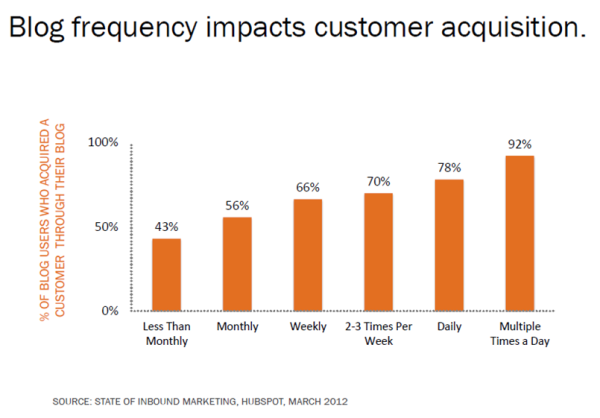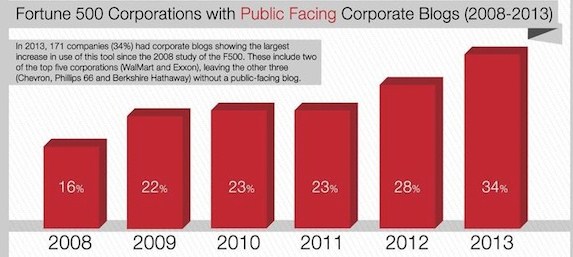Business blogging is an effective way to connect with the public and boost conversions for your company’s services. But what if you understand this and your boss doesn’t? In that situation, it’s your job to persuade the decision-makers that investing in a business blog is a wise choice.
Here are ten of the most convincing statistics you can use in the presentation you’re likely preparing for your boss:
Key Takeaways: The Importance of Business Blogging
- Boosts Site Traffic: Companies with active blogs drive 55% more site visits and have their pages indexed 434% more often.
- Enhances Customer Acquisition: Regular blog updates can lead to higher customer acquisition, with 92% of daily blog-posting businesses reporting at least one customer gained via their blog.
- Outperforms Paid Ads: Blogs attract organic traffic, with 70% of users clicking on organic links over paid ads, making blogs a valuable alternative to traditional advertising.
- Enables Effective Cross-Promotion: Blogs integrate seamlessly with social media, allowing for better tracking of user interactions, sentiment, and engagement across platforms.
- Increases ROI: Inbound marketing like blogging generates leads that cost 62% less than outbound leads, maximizing ROI.
Drumming Up Interest
Getting into business blogging helps your company drum up interest by driving traffic to your site. Companies with active blogs generate 55 percent more site visits, 97 percent more links to their websites, and their pages get indexed a whopping 434 percent more often.
Keeping your blog active dramatically increases the chances of pulling in sales.
A full 92 percent of business blogs that update several times a day have acquired at least one customer through their blog.
As the market rewards business blogging, more companies jump in with both feet. In just the last three years, the population of bloggers has increased by 31 percent.
Advantages Over Advertising
Your company's blog is much more likely to be found by customers.
Today, 44 percent of online shoppers start their search for products and services by using a search engine. Major search engines—and therefore potential customers—are more likely to find you if you're running a blog.
Simply posting paid advertisements on search results pages isn't enough.
Up to 70 percent of the links users choose to click on are organic results, such as business blogs with the appropriate structure and key terms, and not sponsored links.
After years of constant ads, many customers have learned to ignore them.
Business blogs stand out. They often provide helpful or interesting information that people want to find, so 46 percent of folks read blogs more than once a day. They seek out information that interests them instead of having it forced on them, making them much more open to your message.
The Virtues of Cross-Promotion
According to Awareness, Inc.: 96 percent of social media marketers invest in keeping track of how many fans and followers their companies have.
89 percent of them measure their traffic. 84 percent keep an eye on their mentions, and 51 percent track sentiment. Every one of these metrics is easier to track when the views, ratings, and comments are all happening on your blog. Even off-site mentions can be tracked by pingbacks, giving you exacting control over your online image.
Gleanster Research reports that 50 percent of generated leads are qualified but not yet ready to buy.
Rather than losing them and hoping that they remember your business when the time is right, a good business blog with compelling content can keep those leads coming back regularly until the sale is made.
Return On Investment
The heart of any worthwhile business model is always in figuring out how to get the biggest return for the smallest investment.
Business blogging takes this all-important ratio to the far end of the ROI spectrum.
Inbound marketing methods, such as business blogging, generate leads that cost an average of 62 percent less than leads generated via outbound methods.
All the Cool Companies are Doing It
Finally, if your boss has yet to be impressed with the case you're making for a comprehensive business blogging approach to attracting the public, try this:the number of Fortune 500 companies that maintain their own blogs rose by 20 percent from 2012 to 2013, and the rate is accelerating. Fortune 500 companies have never had reputations as early adopters, but even they have been forced into the business blogging arena to compete for customers.
Image: Umass
As these giants' blog presence grows, competition for followers will inevitably grow stiffer.
It's up to you, and to your boss, to make sure you get the jump on them by embracing a comprehensive business blogging approach to your online presence.
BONUS: 5 Tips for Business Blogging
- Take Advantage of Visual Content: Integrate images, infographics, and videos into your blog posts to break up text and make content more digestible. Visuals help illustrate complex ideas and keep readers engaged, enhancing the overall user experience and time spent on the page.
- Utilize Long-Tail Keywords: Target long-tail keywords in your blog posts to capture search traffic from specific queries. Long-tail keywords are often less competitive and align closely with user intent, improving your chances of ranking and attracting highly relevant traffic.
- Focus on User Intent: When crafting blog content, consider the user's purpose behind each search. Structure your posts to answer questions, provide solutions, or educate your audience, ensuring your content fulfills readers' needs and expectations.
- Add Clear Call-to-Actions (CTAs): Every blog post should include a clear call-to-action, whether it's encouraging readers to comment, download a resource, or contact your business. CTAs guide readers to the next step in their journey and increase conversions.
- Optimize for Mobile: A growing number of users are accessing content from mobile devices, so ensure your blog is mobile-friendly. Use responsive design, concise paragraphs, and mobile-optimized images to provide a smooth reading experience across devices.
Conclusion
Business blogging is a proven method for driving traffic, engaging potential customers, and boosting conversions.
By providing valuable, relevant content, a well-maintained business blog not only attracts but also retains customers, helping them make informed purchasing decisions. As consumers increasingly seek organic, informative content over traditional advertising, blogging offers a unique advantage by engaging them on their terms.
With a low investment and high return, business blogging positions your company as a leader in your industry, paving the way for long-term growth and customer loyalty.
Speaking of blogs, did you know you can subscribe to Webquacker's blog and keep on top of the tips, tricks, and amazing inbound marketing strategies we're always talking about here? Sign up and we'll let you know when new stuff is posted. We also never spam your email, because that is the opposite of helpful.
This blog post was first published on Webquacker


